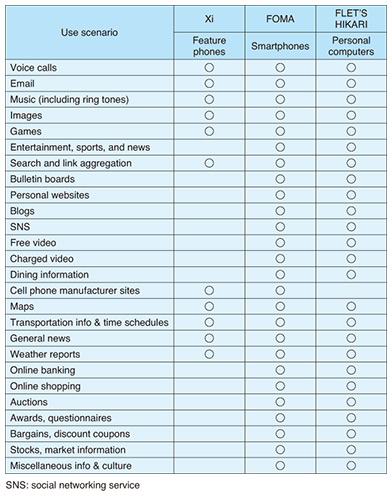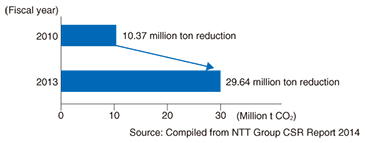 |
|||||||||||||||
|
|
|||||||||||||||
|
Feature Articles: Reducing the Environmental Burden of ICT Services Vol. 13, No. 3, pp. 10–16, Mar. 2015. https://doi.org/10.53829/ntr201503fa2 Evaluation Methods of the ‘By ICT’ EffectAbstractAs a step towards achieving the goals of THE GREEN VISION 2020, the NTT Group’s environmental vision for the year 2020, the NTT Energy and Environment Systems Laboratories has developed various methods to evaluate the ‘By ICT’ effect as a means of evaluating the effect of reducing the societal load on the environment by using information and communication technology (ICT) at the enterprise level. Such evaluation makes it possible to easily calculate the total reduction in the environmental load that results from the ICT services provided by the NTT Group by using business indexes such as sales and number of contracts. Keywords: Green by ICT, environmental load reduction, CO2 emissions 1. IntroductionThere are expectations that the use of information and communication technology (ICT) can reduce the overall load of society on the environment as a measure against global warming [1]. ICT can be used to increase the efficiency of energy use, reduce the production and consumption of products and make the processes more efficient, and reduce the movement of people and goods, and thus reduce CO2 emissions stemming from those activities. Our name for these efforts to use ICT to reduce CO2 emissions in society as a whole is “Green by ICT.” The NTT Group established THE GREEN VISION 2020 as our environmental vision for 2020 [2], which is based on the policies of Green by ICT, Green of ICT, and Green with Team NTT. The objective of Green by ICT is to expand the use of ICT and, specifically, to achieve a reduction in CO2 emissions of 20 million tons by increasing the use of all ICT services offered to customers by all NTT Group companies in 2020. To manage and monitor the degree of attainment of the goal for this objective, a means of evaluating the total reduction in CO2 emissions resulting from the use of ICT services provided by each company (the By ICT effect) is necessary. 2. Development of methods for evaluating the By ICT effectThe By ICT effect for individual ICT services is evaluated by comparing the amount of CO2 emitted when ICT services are used with the same emissions produced when conventional, non-ICT means are used to provide the same functions, as calculated according to environmental efficiency guidelines [3] using the life cycle assessment (LCA) method [4]. The concept of these calculations is illustrated in Fig. 1. In the NTT Group, the By ICT effect of many ICT services is evaluated by using the Environmental Solution Certification System [5].
As the enterprise targets described above, all ICT services offered by an enterprise to customers are subject to evaluation of the By ICT effect. However, the number of ICT services at the enterprise level is very large, so it is difficult to evaluate all of the services individually and to sum them up with limited management resources. Therefore, the challenge was to establish methods for easily estimating the total By ICT effect at the enterprise level by using certain management indexes, such as sales results and numbers of contracts. To meet that challenge, we developed a method for estimating the scaled, overall By ICT effect by multiplying the reduction in CO2 emissions per unit by a scaling factor, under the assumption that the By ICT effect is proportional to a value that represents the number of ICT services offered by an enterprise (the scaling factor). We took the service hierarchy and users into consideration and divided the NTT Group services into solutions, business network services, and consumer network services, and developed evaluation methods for each category (Fig. 2). For the scaling factors, we used management indexes, specifically the sales of solutions and the number of network service contracts for network system services. The evaluation methods for the different categories are explained below.
2.1 Evaluation method for solutionsThe solutions evaluation method [6] estimates the By ICT effect by multiplying the sales (scaling factor) and the unit for calculation. The unit for calculation is the amount of CO2 emission reduction per one million yen of solution sales. We evaluated the By ICT effect for the solutions provided by each NTT Group company according to the guidelines for environmental efficiency, plotted the results against solution sales, and derived linear regression equations. The slopes of the regression lines serve as the units for calculation. Regression equations were derived for the government, finance and insurance, and information and communication industry categories of ICT solutions (Fig. 3). Grouping the solutions by industry confirms that a correlation between the By ICT effect and sales can be obtained. By multiplying the calculation units of each industrial category by the respective sales figures and then summing the values, the By ICT effect for all the solutions of an enterprise can be estimated (Fig. 4).
To share this approach with companies outside of the NTT Group and obtain social recognition, we established the ICT Business Organization LCA Study Group within the LCA Society of Japan in 2012. The Study Group is making progress in setting guidelines for the method of calculating the By ICT effect at the enterprise level. The calculation method provides a basis for setting quantitative environmental targets for companies, quantitative management of goal attainment, and disclosure of information to society. Our objective for the future is to establish a method for quantitatively calculating the By ICT effect on a national level in order to measure how the use of ICT contributes to improving the environment. 2.2 Evaluation method for business network servicesThe method for evaluating business network services applies to leased lines and Internet protocol virtual private network (IP-VPN) services. The By ICT effect for a model enterprise is evaluated according to the guidelines for environmental efficiency evaluation. Assuming a typical model enterprise that uses leased line services, we use the calculated amount of CO2 emission reduction for the model enterprise as the calculation unit. That value is multiplied by the number of service contracts in order to estimate the By ICT effect for typical leased line and IP-VPN services. The evaluation concept is illustrated in Fig. 5. The number of service contracts used is the number for the model enterprise obtained from the number of lines needed for the services and the number of corporate contracts. The By ICT effect for each model enterprise is obtained by multiplying the calculation unit and the number of service contracts, and those values are then summed to estimate the By ICT effect for all business network services.
2.3 Evaluation method for consumer network servicesThe method used to evaluate consumer network services [7] is based on the use of feature phones or smartphones on the mobile network and the use of personal computers on a broadband network. The By ICT effects are calculated by multiplying the calculation unit by the respective scaling factors (number of line contracts). The calculation unit is the amount of CO2 emission reduction per line calculated from typical use scenarios for consumer network services and the corresponding values for conventional means. The use scenarios for broadband and mobile networks are diverse, so we selected use scenarios for which the user rates were 10% or more as typical scenarios after referring to statistical information (Table 1). We obtained the use frequencies for the scenarios and the conventional means that were used in the comparison from questionnaires, and we calculated the amount of CO2 emission reduction according to environmental efficiency guidelines (Fig. 6). User questionnaires were obtained from 1160 people via the web. The calculated units for calculation were multiplied by the respective numbers of contracts to estimate the By ICT effect for consumer network services.
3. Trial calculations of the By ICT effect for 2013We applied the evaluation methods described above in trial calculations of the By ICT effect for the NTT Group for fiscal year 2013 and reported the results in the NTT Group CSR (Corporate Social Responsibility) Report 2014 (Fig. 7). Those results include evaluations for solutions, business network services, and consumer network services, and they indicate that the reduction in the amount of CO2 emissions increased from 10.37 million tons for fiscal year 2010 to 29.64 million tons for 2013. The large increase in the By ICT effect is due to the increase in use time for consumer network services, particularly for broadband networks and smartphones used on mobile networks. The hours of use per day for personal computers and smartphones have risen sharply since 2011, and this fact is reflected in the evaluation results.
4. Future developmentThe NTT Group will continue to work towards reducing the load placed by society on the environment in the future by further broadening the range of ICT use in various fields. By quantitatively assessing that work using the By ICT effect evaluation methods and announcing the results to the public, we will continue to demonstrate the environmental contributions of the NTT Group. We will also continue to expand the use of the By ICT effect evaluation methods, beginning with the work that is already underway to establish guidelines for evaluating solutions. References
|
|||||||||||||||



















